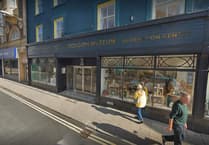Author Jane Blank takes a look at how Christmas celebrations a couple of hundred years ago in mid Wales often lasted for weeks on end, beginning on 6 December and sometimes stretching into February.
Let’s go back in time, to a world before plastic toys, box sets and Father Christmas; further even than the fir trees, and cards of a Victorian Christmas, to Georgian Wales...
There was a huge difference in how wealthy and poor people celebrated Christmas. Squires entertained at home. Their farms, kitchen gardens, mills, gamekeepers, brew and bake houses furnished them with almost everything they needed. Their mansions were well lit with wax candles, their light magnified by burnished metal sconces. Fuel provided by the great estates’ woodlands made even the largest of rooms inviting.
At Nanteos, guests could be accommodated overnight and as recently as the 1950s, friends of the family rode their horses over from neighbouring gentry houses on Christmas night ready for the Boxing Day fox hunt. Though hunting played an important part in the gentry’s festivities, theirs was largely an indoor experience.
In contrast, the poor celebrated largely outside. Out of necessity, they got together through the great wassailing tradition – cramped, dark, damp, their homes could not accommodate guests so they took their fun outside, into the dark.
Holding flaming torches, revellers went from homestead to homestead and tavern to tavern singing and chanting, duelling in ritual verse.
Often these groups included cross-dressing characters, masked up or faces blackened to disguise their identity. They carried props such as the wassail bowl and were accompanied by instruments.
They gathered together outside to travel from neighbour to neighbour where they would be offered food and drink in exchange for music, song, poetry and blessings for good fortune in the year ahead.
Farm work was suspended during the festival period, in some instances the plough was even brought into the house, where it was symbolically retired for the season, lodged under the table and given a drink of hot ale!
At Christmas, both squire and tenant would attend the Plygain service in the local church, rising very early or sometimes staying up all night making cyflaith (treacle toffee), dancing, singing and playing games.
Very early on Christmas morning there was a torch lit procession to the church, with the rector sometimes serenaded by cow horns and drums.
The service lasted for hours, with a short sermon and carols old and new.
Then home to the plygain breakfast of hot ale, toasted bread and cheese or brwes, (oatcake seeped in broth, hot milk and water), strong ales, cakes and cold meats, the goose being kept for the Christmas dinner.
As well as neighbourly visits, Christmas Day was spent in squirrel hunting and violent football matches.
We would probably more easily recognise the wealthy family’s Christmas, not only from film and television portrayals, but from our own experience, as the festive table groaned under the weight of food.
Self-sufficient on their large estates, the rich could nevertheless import goods such as fine wines and spirits from outside the area, even from abroad.
A Georgian Christmas table would contain venison as well as turkey, goose and perhaps even peacock, partridge, turtle, woodcock, hare and plover.
Gone was the Medieval vision of the Boar’s head (accompanied by its own carol) being ceremoniously carried into the great lord’s hall; the festivities of the well to do by this period were more intimate.
Invited guests of roughly the same social class mingled over the holiday period, travelling by coach to one another’s ‘seats’ to celebrate.
Though many mansions such as Plas Nanteos still retained a harpist (who, according to some can be heard to play there still!), the groups of professional minstrels retained by the Welsh lords and princes in earlier times had been replaced by the family and guests singing themselves and playing on harpsicord, flute, violin, cello - though they sometimes hired musicians to play for balls.
But what of Y Werin Bobl? Early winter was a time of plenty, relatively speaking. Though they didn’t have the funds to access imported produce, the harvest would have been energetically preserved by salting, pickling, ‘jugging’, drying, and some fruits and vegetables - such as apples - were still good to eat if carefully stored.
They may also have had homemade beer and fruit wines as well as nuts, dried peas and beans, salt fish and honey.
In addition, the more prosperous farmers would have enjoyed goose, plum pottage (with dried prunes, wine, strong beef or mutton broth, fruit juices, candied peel and raisins) as well as the traditional Christmas pie made out of a boned goose stuffed with boiled ox tongue, wrapped in pastry lined in savoury mince and eaten cold. This was to last all Christmas as fare for drop in visitors.
Poorer people would dance outside and, though the practice of dancing and wassailing was supressed later under the Methodists, figures such as Lois Blake and The Welsh Folk Dance Society have unearthed and carefully preserved many of the dances and tunes they played on their folk fiddles, grwths, recorders and pipes.
St Stephen’s Day was often known as ‘holming day’. The saint had been stoned to death and men and boys took delight in beating women and girls with holly on their bare arms until blood was drawn. Mothers kept their daughters inside for fear of them falling victim!
Farm animals were traditionally bled on this day. It was considered to be good for them and, like their owners, they were not working over this period. Some individuals also ‘holmed’ themselves until blood came.
Historians seem to disagree about the origin of the term ‘Boxing Day’. Certainly there’s a tradition of giving alms on St Stephen’s Day.
Servants, having been tending to their employers on Christmas Day, were often allowed home to their families the following day, carrying with them boxes of left-over food and sometimes gifts from their ‘masters’. As
Christmas Day was for family, so St Stephen’s Day was for friends, neighbours and charitable giving outside the family.
On the day after Christmas the alms boxes were opened and the proceeds distributed to the poor of the parish.
Writers such as Samuel Pepys and Jonathan Swift attest to the habit of giving charitable boxes to the needy and of tradespeople calling on the day after Christmas to collect their ‘box’ of money or goods from their customers.
Amongst many the tradition was to spend Christmas Day with the maternal family; St Stephen’s Day with the father’s family.
Even now Boxing Day is important in the sporting calendar and in Georgian times both the gentry and their tenants would mix via the fox hunt, often ending in a feast and a ball.
Squirrels and rabbits were hunted on this day and, in Montgomeryshire, the last person to lie in was whipped out of bed with holly and forced to do menial tasks for the family all year!
However you chose to spend the festive season, I wish Nadolig Llawen a Blwyddyn Newydd i chi gyd!




